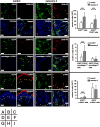Infiltrating CCR2+ monocytes and their progenies, fibrocytes, contribute to colon fibrosis by inhibiting collagen degradation through the production of TIMP-1
- PMID: 31189971
- PMCID: PMC6562037
- DOI: 10.1038/s41598-019-45012-6
Infiltrating CCR2+ monocytes and their progenies, fibrocytes, contribute to colon fibrosis by inhibiting collagen degradation through the production of TIMP-1
Abstract
Intestinal fibrosis is a serious complication in inflammatory bowel disease (IBD). Despite the remarkable success of recent anti-inflammatory therapies for IBD, incidence of intestinal fibrosis and need for bowel resection have not significantly changed. To clarify the contribution of haematopoietic-derived cells in intestinal fibrosis, we prepared bone marrow (BM) chimeric mice (chimeras), which were reconstituted with BM cells derived from enhanced green fluorescent protein (EGFP)-transgenic mice or CC chemokine receptor 2 (CCR2)-deficient mice. After 2 months of transplantation, BM chimeras were treated with azoxymethane/dextran sodium sulphate. During chronic inflammation, CCR2+ BM-derived monocyte and fibrocyte infiltration into the colon and CC chemokine ligand 2 production increased, leading to colon fibrosis in EGFP BM chimeras. In CCR2-deficient BM chimeras, monocyte and fibrocyte numbers in the colonic lamina propria significantly decreased, and colon fibrosis was attenuated. In colon tissue, mRNA expression of tissue inhibitor of metalloproteinase (TIMP)-1 but not of collagen I, transforming growth factor-β1 or matrix metalloproteinases was significantly different between the two chimeras. CCR2+ monocytes and fibrocytes showed high Timp1 mRNA expression. Our results suggest that infiltrating CCR2+ monocytes and their progenies, fibrocytes, promote colon fibrosis by inhibiting collagen degradation through TIMP-1 production.
Conflict of interest statement
The authors declare no competing interests.
Figures








Similar articles
-
CCR2+ monocytic myeloid-derived suppressor cells (M-MDSCs) inhibit collagen degradation and promote lung fibrosis by producing transforming growth factor-β1.J Pathol. 2017 Nov;243(3):320-330. doi: 10.1002/path.4956. Epub 2017 Sep 21. J Pathol. 2017. PMID: 28799208
-
Role of Infiltrating Monocytes in the Development of Radiation-Induced Pulmonary Fibrosis.Radiat Res. 2018 Mar;189(3):300-311. doi: 10.1667/RR14874.1. Epub 2018 Jan 13. Radiat Res. 2018. PMID: 29332538 Free PMC article.
-
Irbesartan, an angiotensin II type 1 receptor blocker, inhibits colitis-associated tumourigenesis by blocking the MCP-1/CCR2 pathway.Sci Rep. 2021 Oct 7;11(1):19943. doi: 10.1038/s41598-021-99412-8. Sci Rep. 2021. PMID: 34620946 Free PMC article.
-
Monocyte subtypes and the CCR2 chemokine receptor in cardiovascular disease.Clin Sci (Lond). 2017 Jun 1;131(12):1215-1224. doi: 10.1042/CS20170009. Clin Sci (Lond). 2017. PMID: 28566450 Review.
-
A deficiency in CCR2+ monocytes: the hidden side of Alzheimer's disease.J Mol Cell Biol. 2013 Oct;5(5):284-93. doi: 10.1093/jmcb/mjt028. Epub 2013 Jul 26. J Mol Cell Biol. 2013. PMID: 23892208 Review.
Cited by
-
Fibro-Stenosing Crohn's Disease: What Is New and What Is Next?J Clin Med. 2023 Apr 22;12(9):3052. doi: 10.3390/jcm12093052. J Clin Med. 2023. PMID: 37176493 Free PMC article. Review.
-
Activin A and CCR2 regulate macrophage function in testicular fibrosis caused by experimental autoimmune orchitis.Cell Mol Life Sci. 2022 Nov 24;79(12):602. doi: 10.1007/s00018-022-04632-4. Cell Mol Life Sci. 2022. PMID: 36434305 Free PMC article.
-
Functionally Relevant Cytokine/Receptor Axes in Myelofibrosis.Biomedicines. 2023 Sep 5;11(9):2462. doi: 10.3390/biomedicines11092462. Biomedicines. 2023. PMID: 37760903 Free PMC article. Review.
-
Cellular and Molecular Mechanisms of Intestinal Fibrosis.Gut Liver. 2023 May 15;17(3):360-374. doi: 10.5009/gnl220045. Epub 2023 Mar 10. Gut Liver. 2023. PMID: 36896620 Free PMC article. Review.
-
Exploring shared pathogenic mechanisms and biomarkers in hepatic fibrosis and inflammatory bowel disease through bioinformatics and machine learning.Front Immunol. 2025 May 12;16:1533246. doi: 10.3389/fimmu.2025.1533246. eCollection 2025. Front Immunol. 2025. PMID: 40421012 Free PMC article.
References
Publication types
MeSH terms
Substances
LinkOut - more resources
Full Text Sources
Medical
Molecular Biology Databases
Research Materials
Miscellaneous

